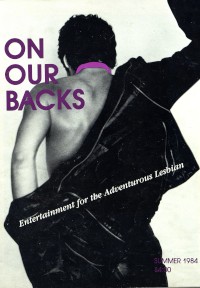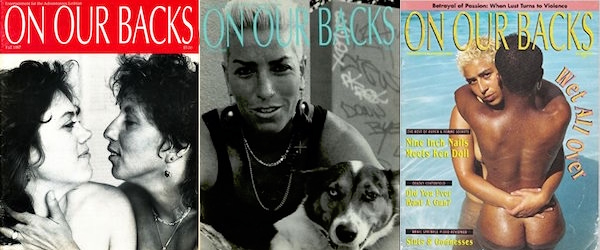Content note: sexual content.
I’m going to make an analogy. It’s going to be flawed, as analogies always are, and if I get stuff about this wrong I hope the people concerned will tell me.

But we didn’t make the magazine for them. We made it for us. When the writers were writing, when the photographers were shooting, when the illustrators were drawing, when the editors were deciding which photos and stories and illustrations and essays and news items to include, we thought about dykes. We thought about the lesbians and bisexual women who were hungry for authentic sexual images of ourselves, who were hungry to see our sexuality recognized and reflected, who were hungry for new ideas about hot things to do in bed. We thought about the dykes who were hungry for a feminism that celebrated the huge variety of lesbian sexual possibilities (i.e., that didn’t shame women for being into kink and dildos and porn).
We never thought, “What will our straight male customers enjoy?”
There were probably male customers who genuinely enjoyed the magazine’s rawness and authenticity. There were probably male customers who wanted to better understand authentic lesbian sexual experience (while getting off, of course, let’s not kid ourselves). There were probably male customers who were just hot for girl-girl action, and didn’t care what form it took (or who subscribed before they figured out what our deal was). It didn’t really matter.
We included images of fat women, butch women, pierced and tattooed women (way the hell before it was cool), women of color, middle-aged and old women. We included erotic stories about all the above. We included articles and essays about homophobia, internal lesbian politics, feminist sex toy stores, battles with anti-porn feminists. We included pictures and stories about pissing, fisting, hard kink, genderfuck, and just plain old sex. The magazine reflected dyke perceptions of sexual attractiveness and sexual desire — lots of dyke perceptions, as many dyke perceptions as we could cram into 64 pages. It was lesbians and bisexual women, talking with each other about sex. The tagline was “Entertainment for the Adventurous Lesbian.” If men were paying attention, they were doing it from the sidelines. If they shared their opinions with us, we mostly ignored them. It wasn’t for them.
When I hear black writers and artists say their art isn’t for white people, that’s what I hear, and that’s the context I hear it in.*
When black writers say that Beyoncé’s Lemonade is not for white people, when Aamer Rahman says his comedy isn’t for white people, when any movie or book or piece of music is described as not being for white people, that’s what I hear, and that’s the context I hear it in. I can enjoy it if I like, it’s nice if I get something out of it — but it isn’t being made for me. It’s being made by and for people whose experiences are different from mine in many ways, people who share cultures and contexts I’ll never fully understand, with language and images and references that are going to go whizzing right by my head. And my opinion about it is not interesting to anyone, other than myself and my immediate circle of friends.
And that’s fine.
It sucks a little — I’m a writer, when I watch a piece of work as extraordinary as Lemonade my reflex is to write about it — but I get it, and it’s fine. My opinion isn’t being solicited, any more than men’s opinions were being solicited at On Our Backs. The overwhelming majority of mass-media art and culture is already made with white people in mind. Some things get to be for other people. Not everything in the world has to be for me.
*This isn’t always what “this isn’t for you” means, of course. Sometimes it really means “go away, this is our space.” And that’s valid.



I’m so glad you wrote this post Greta. I have a friend on Facebook (a white woman) who was conflicted about enjoying and commenting on Lemonade. She heard from black women saying that white women shouldn’t comment on it, but she couldn’t understand why. I sent this post her way and she was appreciative, saying in effect “that makes sense, I get it now”. I think part of the effectiveness was that you are a white woman writing about why a particular form of media isn’t intended for the consumption of white people. A different…lens, if you would, that makes it easier to understand than if my friend had read a piece from a black woman.
makes sense to me
I remember that magazine! I started managing a bookstore / newsstand in 1990 and we had an extensive zine/magazine section that was very daring for Asheville NC. We carried On Our Backs. We also carried the gay guys mags but the owner ws a lesbian so we tried to carry as many mags as possible for them. And it’s no accident that our little city has a huge lesbian/queer population. OOB was a really classy mag.
So I had to come back and reread this post after seeing some of the conversation about it on Twitter. I was wondering if I had somehow missed something. But no, not at all…everything you say here still makes perfect sense.
I just can’t quite grasp why anyone would have a problem with the fact that some art is directed at a particular audience.
To try another analogy…I work as a technical writer for a living, which in my case primarily means I write about software. One of the first tasks in creating any sort of document / manual / whatever in this field is to ask “who is our audience?” The answer to that informs the work on multiple levels. If my audience is primarily people who are new to computers, I’m going to write something very different than what I’d write for, say, software developers, even if it is the same topic.
If I’m writing for an advanced audience, I can make some very basic assumptions about my audience, the terms they should already know, the concepts that I shouldn’t need to explain. Someone who is not part of that audience can still read the work, but they probably won’t get much out of it. And if they send me feedback complaining that it doesn’t meet their needs, I’m not going to be terribly concerned.
Don’t *all* works of art — writing, music, whatever — have some sort of intended target audience? How could that idea be controversial? Maybe the creator of the art didn’t sit down and analyze that audience the way I do for my technical writing work, but the audience is there. And it informs the work in many ways. Just as I don’t need to define techy terms for a techy audience, an author writing a novel aimed at people with a particular background is probably not going to worry about explaining terms and cultural references that might not make sense to people without that background. Their target audience knows these things and would probably get impatient with those explanations.
Anyway, great post.
I agree that the suggestion that media targeted at minorities are somehow racist is pretty ridiculous, but I think a lot of the dispute comes from the ambiguity that arises when one says that a particular product isn’t “made for white people.” I visited the blog post you linked to in this current post, and what you included in the footnotes seems to me to be a possible interpretation of the phrase that could result in a less receptive response. I also agree that declaring that certain media isn’t made for whites with that implied meaning is valid and acceptable, but for the potential audience of white people who might be interested in a certain product (in this case, for Beyoncé’s new album), I think it’s easy to see how such subtext could result in some complaint.
In terms of overall media representation, I believe that some (but certainly not all) of the disparity in terms of media marketing to different demographics has to do with the overall makeup of Non-Hispanic whites (about 5 in 8 Americans, if memory serves) and the composition of minority groups (I think it’s about 1 in 8 for Black Americans, for example). Overall, I think that’s it’s pretty unfortunate that the desire for profit (in and of itself reasonable) leaves so many minorities firmly under the bus.
(I’m Asian, so guess I might be kind of removed from this discussion. That’s not to say that I don’t like Beyoncé’s work, though.)